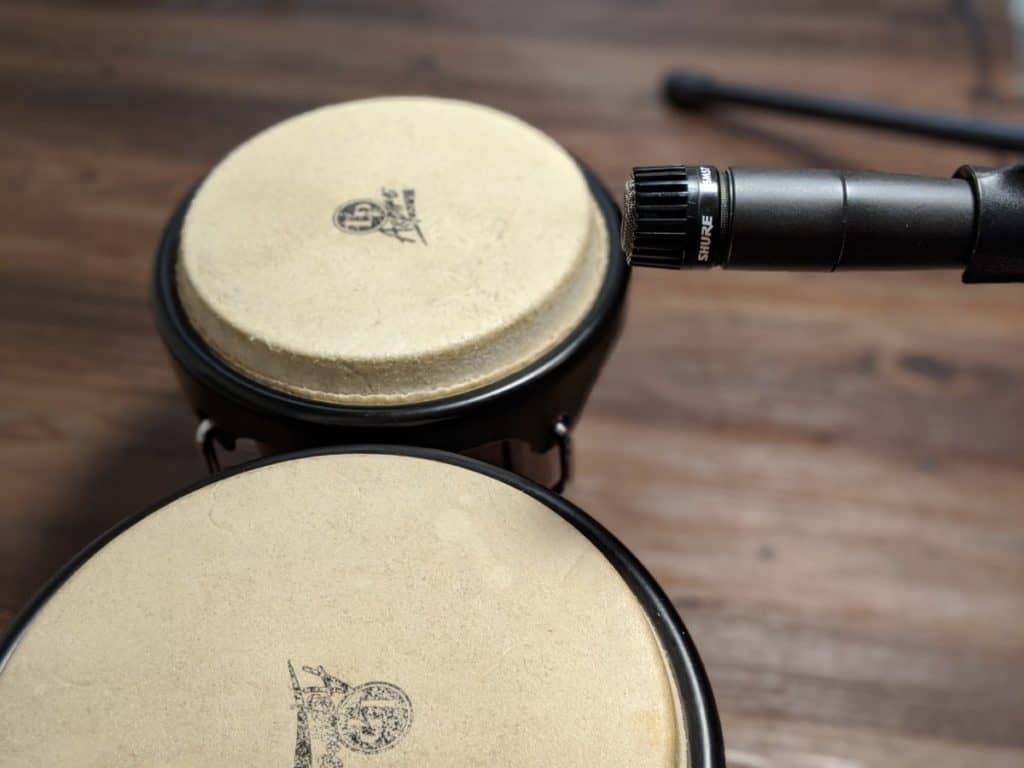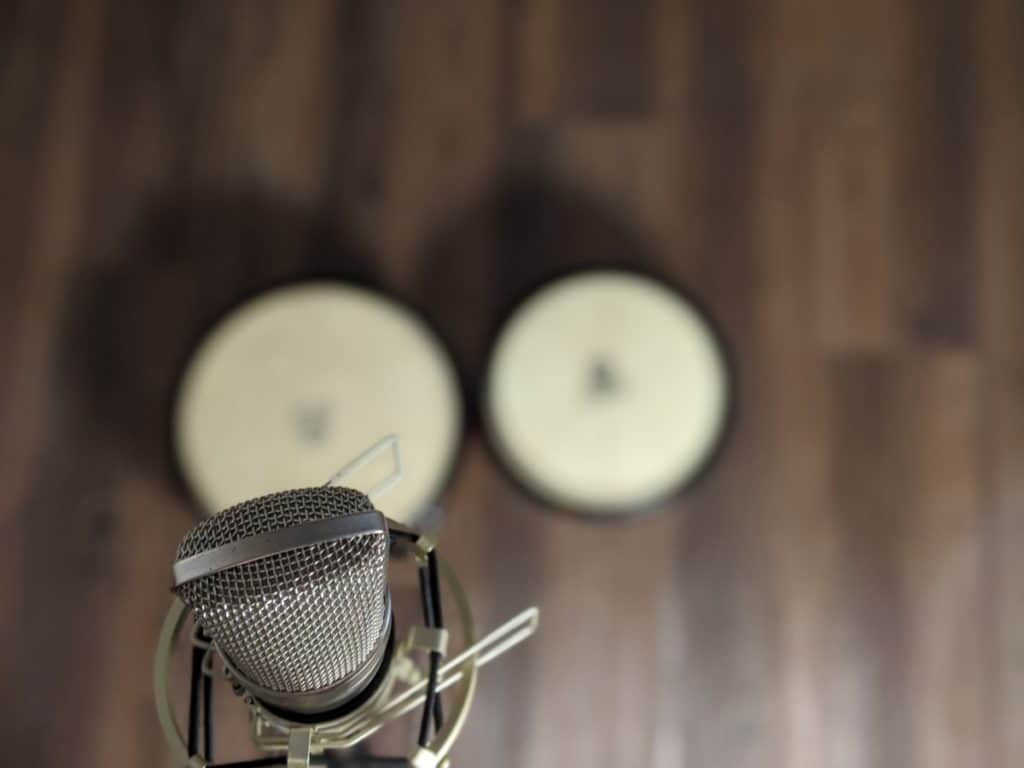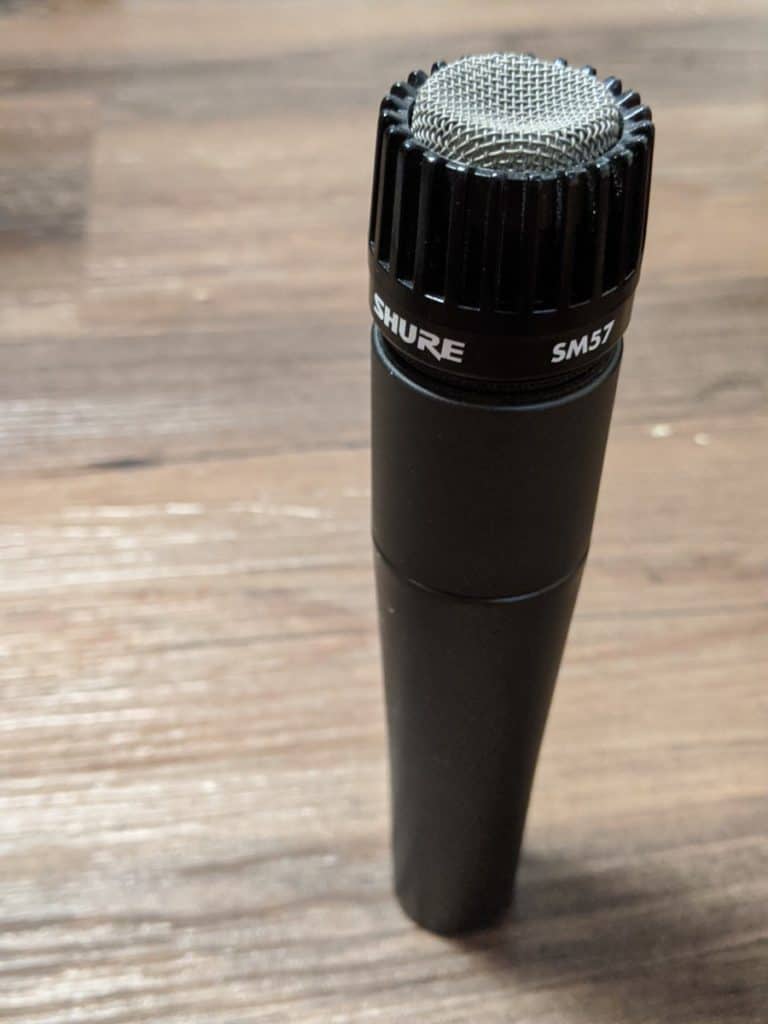This post contains affiliate links. We earn commissions if you purchase products from retailers after clicking on a link from our site. As an Amazon Associate, we earn from qualifying purchases.
I have tried to record the bongos several times over the years and I have never done an in-depth study on the best way to record bongos.
The most straightforward and common way to record bongos is to directly mic them by placing a dynamic mic 3-6 inches above the center, off to the side, and between the two bongo drums.
There’s a lot more to know about why you would choose to mic your bongos this way, and there is more to learn about other ways you can mic your bongos.
The Most Practical Way to Mic Your Bongo Drums
Later on we’ll talk about figuring out the sound you want, but for now, I’ll tell you the easiest way to get the best sound from your bongo drums.
Materials Needed
- Bongo Drums
- Mic Stand
- Dynamic Mic (like the Shure SM-57) OR a condenser mic
- Bongo Stand or a Bongosero (you) to hold the Bongo Drums
I’m assuming you have the cables and audio interfaces necessary to plug in a dynamic mic into your recording device of choice.
Setting Up Your Bongos
If you’re lucky, unlike me, you would own a bongo stand. Bongo stands are very nice because they enable you to play bongos while standing, and make it a lot easier to mic your bongos because they won’t be moving.
If you’re like me, you don’t own a bongo stand, yet, so you have to hold the bongos between your knees in the traditional manner. No big deal, it still works.
Once you have your bongos mounted where you want them, or if you have your bongos situated comfortably (as comfortably as is possible I suppose) between your knees, then you’re ready to position the mic.
Positioning the Mic
Use your mic stand to position your dynamic mic with the following parameters:
- Position the microphone pointing across the bongo drums, there is no need to point the microphone directly at the bongo drums
- Position the mic parallel to the bongo drum heads about 3-4 inches above the bongo drumheads, between the two bongo drums
- The mic can be around an inch away from the side of the bongos so the mic does not interfere with the bongo player. The player of the bongos.

By the way, looking for recording equipment and musical instruments? Check out Sweetwater.com for microphones, monitors, audio interface or any other recording gear that you could ever need. (Affiliate Link)
Alternative Mic placements
As contrast, another idea is to put the mic closer to the macho (the smaller drum)–since the macho has the high crisp sound and the hembra has the low resonant sound, the macho is often more desired in your track than the hembra. As always, experiment to find the sound you like.
Adjusting Your Mic Levels
For my dynamic mic (Shure SM-57) with my particular audio interface (the Shure X2u), I set my mic gain to as high as it could go and I didn’t have any clipping with this set up. For your mic, set the gain as high as it can go without clipping (green or yellow light, never red).
It’s easy to set the mic gain too high on drums because it’s hard to adjust for the big variance in pop that drum players inevitably have. In your sound check, let the bongo player hit the drums around the same intensity as they will be in performance and adjust accordingly.
Advantages of Using a Dynamic Mic for Recording Bongo Drums
Dynamic mics are great at getting up close and personal to the sound and ignoring everything else going on. This is really nice in performance so you don’t get feedback from other players. The diaphragm of dynamic mics are also small and robust enough to handle the sound of your drums without any issues.
The SM-57 is considered a workhorse of recording. It’s practically a brick; really tough, and used often for recording drums. This dynamic mic has the advantage of being high quality and fairly affordable as well.
Advantages of Using a Condenser Mic for Recording Bongo Drums
The best advantage for condenser mics as I will go into more detail later is that you are able to capture more of the sound of the room. This can open up your bongo sound, if that’s what you are looking for (the majority seems to prefer a closed more direct sound).
If you put the condenser mic closer to the bongo drums, this will be less of an issue–however, condenser mics shouldn’t be too close to a loud source or you could risk damaging them.
Summary
That’s it! You’re going to get a nice crisp sound that avoids getting the room sounds and allows the bongo player enough room to play without the mic getting in the way.
This is a recording of this setup with a SM-57 dynamic mic, 3 inches from the bongo drumheads:
If perhaps you want more “room” in your sound, or if you are dissatisfied with how the dynamic mic may sound, read on for more options for modifying your sound.
Deciding on What Sound You Like
The first thing to decide is what kind of sound you are looking for your bongos in your recording.
The biggest factor on your sound recording bongos is how much room sound you have.
Room Sound
Room sound is the effect of the room–including echos and reverberation from the walls–on your sound.
Room sound can give your bongo recording a sense of space, adding more dynamics and humanization of your sound. Some think that you get more of a classic bongo sound when you include more room sound. This is likely because old band recordings with bongos didn’t directly mic the bongos.
Room sound of course varies tremendously from room to room. If you are in a square room without soundproofing, in general you’re going to get a reverb that doesn’t sound good, as the sound waves will echo and cancel each other out, affecting tone.
Room Sound can be awesome for your track. However, it depends on your track, and it depends on your room.
If you want to get more room sound, simply move the mic farther than the bongos.
Examples of Room Sound with a Dynamic Mic
I decided to a little experimentation that may help you as you’re trying to figure out just the right bongo drum sound for your track. I recorded the bongo drums at the same levels in the same room in the same place with varying distances from the bongo drums.
I normalized all the tracks so you could hear the effect of the room in the sound better without having to crank your speakers. You will notice some noise in the recordings at farther distances.
For reference, here is the original recording at 3 inches above the bongo drums:
Here is the recording at 6 inches above the bongo drums:
Here is the recording at 12 inches above the bongo drums:
Here is the recording at 24 inches above the bongo drums:
As you can see, the farther away the dynamic mic gets the more of the sound of the room it picks up. However, you’ll also notice that with the dynamic mic, it starts to lose out on the softer hits and starts picking up more noise (that unpleasant high pitched noise especially)
Avoiding Room Sound
So, if you want your recordings to be as clean as possible with as little room noise as possible, it’s important to use a dynamic mic and get close to the bongos. Condenser mics will work, but you will pick up more room sound.
Using a Condenser Mic for Recording Bongos
Condenser mics are more sensitive because of their large diaphragms, and thus aren’t the go to mic for other percussion in many cases (like a drum kit for example), however, it can work really well for your sound if you get proper distance. Often condenser mics are used for Latin percussion where direct mics aren’t used. Additionally, if you have a great room space, a condenser mic will pick up that room sound as it also picks up your bongo sound.
I recorded the bongo drums in the same location as the recordings above, except I used my MXL V88 condenser mic, and I raised the mic 24 inches above the bongo drumheads.

As you can tell, the bongo drums still feel close, but you get that room sound. My room isn’t really great for recording, so this isn’t ideal for my situation, but if you do have a room sound that you want to capture, using a condenser mic is a great way to go.
Again, I apologize for the sound of the bongos… I do not have a bongo stand, but you definitely can get the idea here.
Condenser mics shouldn’t be directly by the bongos, but can be as close as 12 inches to 24 inches.
Recording Bongos in Mono or Stereo
This is a borderline holy war topic–there are a lot of different opinions on whether bongos or congas should be recorded in stereo (one drum per channel).
This is ultimately up to your preference, but from my research, it makes the most sense to record bongos in mono. Bongo drums almost always have one place in the soundscape. You won’t hear the hembra and the macho in different panning scenarios. If you are going to pan the hembra and the macho together, then it makes sense for the drums to be recorded together in mono.
It’s understandable why this question comes up because when we mic a drum-kit we have a separate channel for the bass, the cymbals, the snare, the hi-hat, etc. This is different though when you think about it, because the different drums play very different roles in a song, and therefore need to be equalized and treated differently.
Ultimately, it’s your choice, but I’d say simplify your life and put the bongos in one channel.
Best Mic for Bongos
During my research, I confirmed my earlier suspicion that the SM-57 microphone by Shure is one of the most common microphones used for recording percussion, and bongos are no exception.

The SM-57 is a fantastic dynamic mic ideal if you want a close, direct and clean sound.
The DPA 4099d is a clip-on condenser mic that has warm reviews for recording bongos. It requires phantom power.
The SM-98 is another miniature condenser mic that can be clipped on to the drums
Audio-Technica’s AT4040 is another Condenser mic that can be used for mic’ing the bongos directly or for capturing ambient sound.
The SM-81 is a high-quality condenser mic that will work well for bongos.
Alternative Mic Positions
As I was doing research I found a lot of different methods and microphones used for mic’ing bongo drums
Clip-On Mics for Bongos
I saw a YouTube video where a guy was using a clip-on mic, and I spent half an hour tonight trying to find it for you, but I failed. I read about others, however, that use clip-on mics for bongo drums. You can clip it one of the two drums and angle the microphone to be centered (or biased towards the drum you want to capture more).
A small-diaphragm condenser or a dynamic mic would work well for this purpose because of the close proximity.
Ambient Microphones
Bongo drums have an exotic sound by themselves, and having a good room sound can really add to the feel. You can achieve this with a condenser mic overhead or otherwise farther away from the music.
Mic’ing Bongos From Below
This is generally not considered the most ideal position for recording bongos, but it is done. Some have placed the microphone facing up at the same level of the bongo drumheads, while others have even placed the mic under the bongoseros chair. I can’t speak to these method’s efficacy, personally but just know that some audio technicians have done this with some success.
